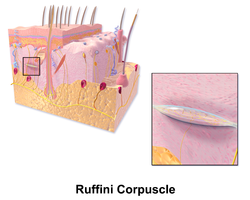Bulbous corpuscle
| Ruffini ending | |
|---|---|
 | |
 Nerve ending of Ruffini. | |
| Details | |
| Part of | Skin |
| Function | Mechanoreceptor |
| Identifiers | |
| Latin | corpusculum sensorium fusiforme |
| TH | H3.11.06.0.00017 |
| TE | corpuscle_by_E5.17.1.0.2.0.15 E5.17.1.0.2.0.15 |
| FMA | 83602 |
| Anatomical terminology | |
The bulbous corpuscle, Ruffini ending or Ruffini corpuscle is a
Structure
Ruffini corpuscles are enlarged dendritic endings with elongated capsules.[1]
Function
This spindle-shaped receptor is sensitive to skin stretch, and contributes to the kinesthetic sense of and control of finger position and movement.[3] They are at the highest density around the fingernails where they act in monitoring slippage of objects along the surface of the skin, allowing modulation of grip on an object. [citation needed]
Ruffini corpuscles respond to sustained pressure[4] and show very little adaptation.[5]
Ruffinian endings are located in the deep layers of the skin, and register mechanical deformation within joints, more specifically angle change, with a specificity of up to 2.75 degrees, as well as continuous pressure states. They also act as thermoreceptors that respond for a long time, so in case of deep burn there will be no pain, as these receptors will be burned off.[6]
References
- ISBN 978-0-07-067722-7.
- ^ Molnár Z, Brown RE., 2010. Insights into the life and work of Sir Charles Sherrington. Nat Rev Neurosci. 11(6):429-36
- ^ Mountcastle, Vernon C. (2005). The Sensory Hand: Neural Mechanisms of Somatic Sensation. Harvard University Press. p. 34.
- ISBN 978-0-07-067722-7.
- ISBN 81-8147-057-5.
- ^ Hamilton, Nancy (2008). Kinesiology: Scientific Basis of Human Motion. McGraw-Hill. pp. 76–7.
External links
- Paré M, Behets C, Cornu O (2003). "Paucity of presumptive ruffini corpuscles in the index finger pad of humans". J Comp Neurol. 456 (3): 260–6. S2CID 13396416.
